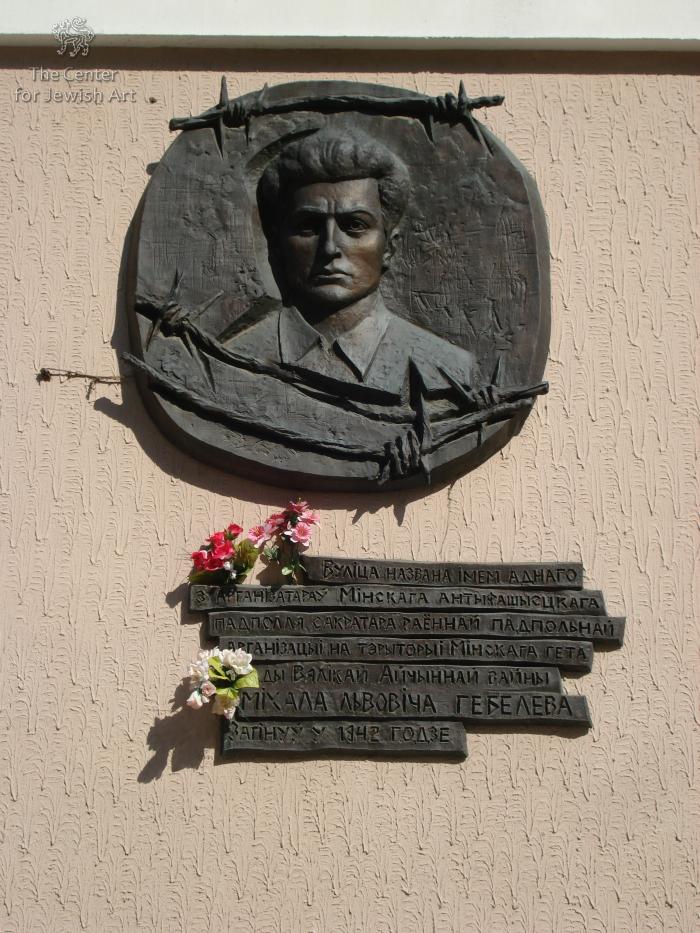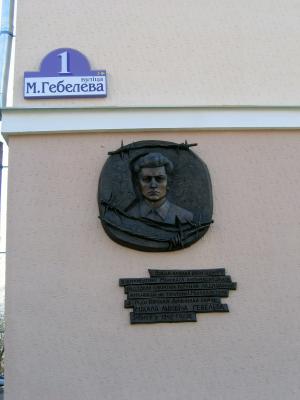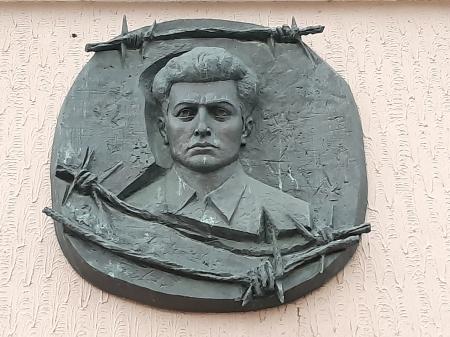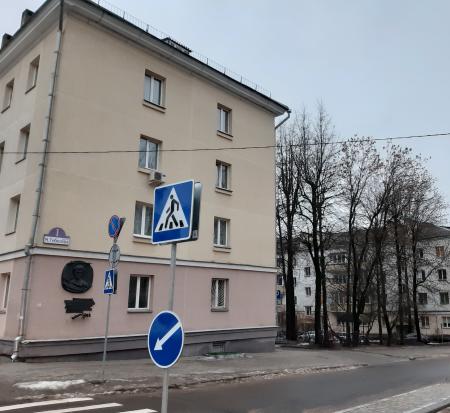Obj. ID: 47055
Modern Jewish Art Memorial plaque to Mikhail Gebelev in Minsk, Belarus, 2005

Who is Commemorated?
Mikhail Gebelev, a leader of a resistance organization in the Minsk ghetto.
Description
This memorial plaque takes the form of an uneven circle. The architect Leonid Levin used a yellow round badge that Jews had to sew on their clothes in the Minsk Ghetto as the basis for the artistic idea [Levin, 2011]. The edges of the plaque are uneven, just as the edges of the yellow badges worn by each prisoner of the ghetto were uneven. On this uneven circle, there is a bas-relief with a portrait of Mikhail Gebelev and fragments of barbed wire in high relief. Under the relief plaque, there is a bronze plaque with an inscription in Belarussian.
Inscriptions
Belarussian:
Вулiца названа iмем аднаго
з арганiзатараў Мiнскага антыфашысцкага
падполля сакратара раённай падпольнай
арганiзацыі на тэрыторыi Мінскага гета
ў гады Вялiкай Айчыннай вайны
Мiхала Львовiча Гебелева
Загiнуў у 1942 годзе
Translation: The street is named after one of the organizers of the Minsk Anti-fascist underground, the secretary of the district underground organization on the territory of the Minsk Ghetto during the Great Patriotic War, Mikhail Gebelev, died in 1942.
Commissioned by
Svetlana Gebeleva, Financed by the Minsk City Executive Committee
sub-set tree:
Text Plaque: 50 cm
The Minsk Ghetto was established in mid-July 1941 in the Rakov suburb, the oldest and poorest section of the city. As early as August 1941, a clandestine resistance organization was established in the ghetto. The cell was headed by the Polish communist Hersh Smolar and the local communist Mikhail Gebelev. The resistance in the Minsk Ghetto concentrated primarily on smuggling as many Jews as possible out of the Ghetto and into the forests, which were home to partisan units. The Ghetto was liquidated in June-October, 1943. [Minsk, Untold Stories]
Mikhail Gebelev was detained by the Gestapo, in July 1942, and executed in a Gestapo prison.
The story of Mikhail Gebelev became widely known thanks to the memoirs written by Hersh Smolar, who survived the Holocaust.
The idea to commemorate the memory of Mikhail Gebelev belonged to his daughter Svetlana Gebeleva (USA). The memorial plaque is installed on a building located along the borders of the former Jewish cemetery and the Minsk ghetto's location from 1941 through 1943. The unveiling of the memorial took place on October 15, 2005, the day of the 100th anniversary of Mikhail Gebelev's birth.
Levin, Leonid, Perezhit perezhitoe (Minsk: 2011)
On Holocaust in Minsk, see
On Leonid Levin and his Holocaust Memorials, see
Sahm, Astrid, "Holocaust Memorials in the Belarusian Culture of Remembrance," in: Killing Sites – Research and Remembrance (Berlin: Metropol, 2015), 191-203., https://www.academia.edu/11753495/Holocaust_Memorials_in_the_Belarusian_Culture_of_Remembrance (accessed January 23, 2023)
Sahm, Astrid, Architektur als Gratwanderung. Leonid Levin – ein Werk als Brücke von Gedächtnis und Gegenwart (Minsk: IBB, 2008)
Smolar, Hersh, The Minsk Ghetto: Soviet-Jewish Partisans against the Nazis (New York: Holocaust Publications, 1989).







